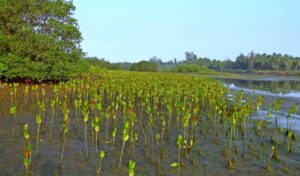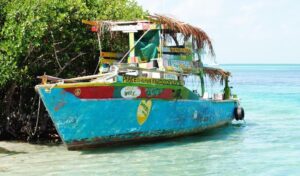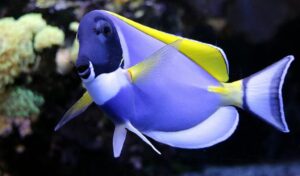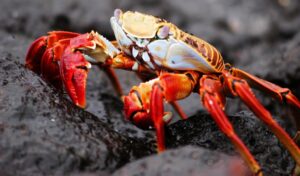Marine and coastal ecosystems are the most threatened in the world — a fact that must receive greater attention if governments are going to successfully reverse pollution trends and restore the health of the world’s oceans.
With the recent news that a U.S. Supreme Court corrupted by fossil fuel companies has undermined the U.S. Environmental Protection Agency‘s ability to regulate carbon emissions, the need for strong, honest leadership is crucial. At the end of this article, we’ll list the recent actions announced by the Biden Administration to help restore ocean health and boost coastal resilience.
There’s good news in other nations, too. For instance, Australia recently ejected the clueless conservative party that had made that country a global climate laggard at the national level (some states and cities already had more-enlightened governance).
Alternate paths to global regeneration was the subject explored by speakers in the third interactive dialogue taking place alongside the 2022 Ocean Conference on June 28, 2022 in Lisbon, Portugal, which focused on solutions.
“Without political will, we will not make it,” said Isabella Lövin, Co-Chair of the Friends of Ocean Action and Former Deputy Prime Minister of Sweden, who moderated an afternoon discussion on “Managing, protecting, conserving and restoring marine and coastal ecosystems”. Without regulatory frameworks, conditions will continue to worsen.
She said this is the most important conversation to have, as it provides the right entry point for achieving Sustainable Development Goal 14 in its entirety. She encouraged participants to grapple with how to define a healthy ecosystem, pointing out that the world lacks an operational definition of what is meant by marine ecosystem health.
Panelists presenting their findings today included Elizabeth Mrema, Executive Secretary, Secretariat of the Convention on Biological Diversity, Montreal; Martha Rojas-Urrego, Secretary-General, Ramsar Convention on Wetlands, Gland, Switzerland; Zhang Zhanhai, Special Envoy for China, Chief Engineer, Ministry of Natural Resources, China; and Marco Lambertini, Director General, World Wildlife Fund International, Gland, Switzerland.

Photo of mangrove seedlings in India by Bishnu Sarangi from Pixabay
Ms. Mrema said biodiversity, like the ocean, does not recognize national boundaries. The drafters of the Convention on Biological Diversity affirmed that conservation is a common concern, and as such, a collective response is needed to preserve nature for future generations. Nature, through its ecological and evolutionary processes, sustains the quality of air, water and lands on which humans depend.
“Nature has been sounding its alarms,” she said, stressing that more food, energy and materials are being supplied today than ever before, at the expense of nature’s ability to continue to provide such contributions.
Moreover, she said half of live coral cover has been lost since the 1870s, with accelerated losses due to climate change. Marine plastic pollution has increased ten-fold since 1980, affecting 257 species, while 66 per cent of the ocean area is experiencing the cumulative impact from multiple forces.
Over the last 50 years, the human population has doubled, while global trade has grown ten-fold. She called for addressing the drivers of biodiversity loss by engaging sectors that have an impact upon it, empowering stewards — including indigenous peoples and local communities — and treating biodiversity as the valuable asset that it is.

Coral. Photo by Marcelo Kato from Pixabay.
Ms. Rojas-Urrego said marine and coastal ecosystems are essential to achieving Goal 14. More than 3,000 species of fish depend on mangroves, while turtles and manatees need them to survive. These ecosystems are important for the flows of water and sediments. They store carbon and are a source of livelihoods.
However, they are the most threatened ecosystem today. The world has lost 87 per cent of its wetlands — 35 per cent in the last 30 years — and 67 per cent of its mangroves, three times faster than forests.
Going forward, she said governments must prioritize the conservation and preservation of marine and coastal ecosystems, integrate this protection into ocean strategies and take a source-to-sea approach in doing so. It is also vital to take area-based measures and focus more on the link between marine and coastal ecosystems and climate change.
These areas are the most efficient carbon store. Mangroves store carbon 55 times faster than all the forests in the world. Along with coral reefs, they reduce the impact of extreme events and should be part of the nationally determined contributions. Yet, only 21 per cent of them include wetlands in the area of mitigation. She also called for strengthening data and science.
Mr. Zhang, describing national actions, pointed to a law aimed at protecting coastal ecosystems, as well as the introduction of coastal protection initiatives into overall planning efforts. Among other measures, China has restored coastal wetlands, improved ecosystem resilience, and issued opinions on encouraging private capital into ecological protection and market-based solutions. It has promoted nature-based solutions and ecosystem-based methods within its protection efforts.
Noting that since 2015 China has carried out 24 coastal zone restoration projects, he said it also has held seven international training courses that have been applied in 20 countries. He underscored the importance of shouldering common but differentiated responsibilities, noting that China also will explore ways of enhancing carbon sink capacity of marine ecosystems and has looked positively on the proposal to create a global coastal forum to promote protection.
Mr. Lambertini said ocean conservation is no longer simply an ecological issue, as it is impacting the economy, social stability and the sense of intergenerational justice. From an economic perspective, the World Wildlife Fund and Boston Consulting Group developed an assessment for gross marine product, based on the same metrics used for gross domestic product (GDP). By that measure, the ocean constitutes the seventh-largest economy, generating $2.5 trillion in goods and services every year.
“We need to protect more of the ocean — and in the right places, in the right way,” he stressed.
There is an opportunity to develop new governance for the high seas, which are vital to ensuring the interconnectedness of the oceans by providing safe migratory corridors for fish.
Underscoring the need to stop funding over-fishing, he welcomed the “fantastic” World Trade Organization (WTO) decision last week in which, for the first time in 20 years, subsidies for over-fishing and illegal, unreported and unregulated fishing will be significantly diminished. This is historic, since the primary purpose of the WTO when it was founded was to prevent nations from establishing environmental protections.
Launching the interactive dialogue, Tony Holmgren, Chief Executive Officer of the Stockholm International Water Institute, lead discussant, said the only lasting solutions are the strong partnerships forged between actors on land and at sea. He called for investing in science, education and monitoring of the economic links across the source-to-sea continuum.
Decision-makers must always ask the question “what are the consequences downstream”, he said. He also called for creating institutions and incentives that prompt decision-makers to consider the downstream impact of daily operations, among other solutions to create a “water-wise world.”
Lead discussant Mami Mizutori, Special Representative of the Secretary-General for Disaster Risk Reduction, cited a study showing that if current trends continue, there will be 560 medium-to-large disasters per year by 2030 — or 1.5 per day — which will disproportionately impact coastal areas and small island developing States. At their heart are unsustainable consumption and production patterns.
“We are living outside the boundaries of what the planet can sustain,” she warned, calling for a “radical” change in how decisions are made by comprehensively managing systemic risks and placing disaster risk reduction at the core of priorities. National and local strategies for disaster risk reduction also must be aligned with environmental policies, while multi-hazard risk data must be both collected and analyzed.
When government and other participants took the floor, several offered solutions, with Albert II, Sovereign Prince of Monaco, focusing on local approaches, as the scope of the task ahead could discourage “even the boldest”. Protected marine areas provide some of the most effective solutions to recover marine and coastal ecosystems. Yet only 8 per cent of surfaces are protected, far short of what is needed.

Coastal resort in Fiji. Photo by Lee Chandler from Pixabay.
Frank Bainimarama, Prime Minister of Fiji, speaking for the Pacific Islands Forum, said the Pacific region has experienced climate change, pollution and biodiversity loss with a severity that rivals war.
Recalling that only 4 per cent of the Pacific territory is land — and that the rest is ocean — he said the goal to protect 30 per cent of the ocean offers a huge opportunity to develop domestic blue economies. He said he is excited about the future and called for a new way of thinking that is centered on people and nature.
“By the time we leave Lisbon, we need the world with us,” he insisted.
Silas Bule Melve, Minister for Climate Change of Vanuatu, speaking for the Pacific small island developing States, said the Pacific region is home to the world’s largest tuna population, and by far remains among the best managed fisheries. Its success is based on a long history of managing coastal resources through strong marine protected area approaches, whereby traditional concepts have been translated into modern protection efforts.
This is but one example of how the traditional knowledge of indigenous peoples and local communities can inform actions to conserve and restore ecosystems, especially mangroves, sea grass and coral reefs. He also called for strong practical action for species protection.
Mark Harbers, Minister for Infrastructure and Water Management of the Netherlands, noting his country is a low-lying delta nation, said the Netherlands believes in a sustainable blue economy. It advocates a strong evidence-based ocean policy and close cooperation among Governments, knowledge institutions and the private sector. He pointed to the North Sea Roundtable as a good example.

cay Caulker, Belize. Photo by Elizabeth ST. Gonzales from Pixabay.
John Briceño, Prime Minister of Belize, said his country was among the first to restructure its national debt for marine conservation. With an unsustainable $550 million bond, Belize convinced bond holders to help it emerge. It took a haircut of 45 cents on the dollar, saving $250 million.
“It was painful but it was necessary,” he said, noting that it is now using money from its blue bonds for marine conservation. It set up a marine conservation fund, which will be worth $100 million by 2040. Belize, through the blue bond, will see 30 per cent of its ocean space protected “well before” the 30 by 30 target, he said.
Minna Epps, International Union for Conservation of Nature and Natural Resources (IUCN), noting that the latest Intergovernmental Panel on Climate Change report found that countries must protect 30 to 50 per cent of the ocean, urged countries to protect at least 30 per cent by 2030, and further, to conclude the treaty for marine biodiversity in areas beyond national jurisdiction in 2022.
Francisca Eneme Efua, Minister for Agriculture, Livestock, Forests and Environment of Equatorial Guinea, said her country comprises a continental part along the Atlantic coast, as well as two volcanic islands, covering 24,000 square kilometers. She pointed to the adoption of several laws, notably for protected areas, waters and coast, fishing and agricultural activities, and for hydrocarbons and fuels.
The Minister for Fisheries and Ocean Policy of Norway said his country is “world leading” in the areas of sustainable knowledge-based management and related ocean technology, pointing out that it launched a blue justice initiative in 2019.
“The ocean responds to wise ways of using it,” he said. Decline can be turned around.
The blue ecosystem has much more to give if “we are able to adapt and interplay with it,” he said, stressing that there is still time to realize true sustainability if governments “future proof” decision-making by using the best available science, ensuring a common commitment and engaging in cooperation.
Bianca Dager, Vice Minister for the Environment of Ecuador, said her country is among the 17 that are home to two thirds of all biodiversity, and the only one in Latin America to establish a policy of ecological transition.
One coastline runs along 29 cantons, exporting $7 billion in aquaculture and fishery activities, as well as 40 per cent of non-oil exports. Noting that a dead shark sells for $100, while a live one could fetch “a thousand times more”, she described the establishment of a reserve on the Galapagos that has generated huge benefits for Ecuador and includes an agreement with the fisheries sector. Ecuador also has tripled the area of one particular mangrove reserve and set up a payment scheme for preserving mangroves.
Hugo Moran, Secretary of State for the Environment of Spain, announced a new goal to achieve 25 per cent of protected marine areas as an interim step towards reaching the 30 per cent target by 2030.
A speaker from the Australian Seaweed Institute, who said she represents the Safe Seaweed Coalition, a network of 800 members across 75 countries, drew attention to scalable nature-based solutions to absorb phosphorous and carbon from the marine waters, as well as several seaweed innovations. Among them, she noted that feeding cattle seaweed can reduce their methane emissions by 82 per cent.
Also speaking were senior officials from Timor-Leste, Indonesia, United States, Ireland, Cuba and Greece, as well as a speaker from French Polynesia.
Tanya Plibersek, Minister for the Environment and Water of Australia, and Ximena Fuentes, Vice-Minister for Foreign Affairs of Chile, co-chaired the meeting.
Recent Biden Administration announcements related to restoring ocean health and boosting coastal resilience:
During the United Nations (UN) Ocean Conference held in Lisbon, Portugal, the Biden-Harris Administration announced a number of steps the Administration is taking to work with global partners to combat the climate crisis and boost the ocean economy. These new actions included: the acceleration of efforts both across the U.S. Government and internationally to combat illegal, unreported, and unregulated fishing and associated labor abuses; support for aquatic and blue foods contributions to food security; the announcement of Bipartisan Infrastructure Law funding for ocean and coastal resilience, habitat restoration, and marine debris prevention; leadership on the development of an action plan to conserve, restore, and sustainably manage global coral reef ecosystems; and the release of a national Ocean Policy Committee Action Plan; among others.
This week’s actions build on President Biden’s proclamation declaring June as National Ocean Month and key announcements the White House made in June to conserve and restore the health and productivity of the ocean for the benefit of all Americans. These announcements included initiating the designation process for a new national marine sanctuary to conserve Hudson Canyon in the Atlantic Ocean; a phase out of the sale of single-use plastics in national parks and public lands; the launch of efforts to create America’s first-ever Ocean Climate Action Plan; and the launch of an initiative to center environmental justice in ocean science and technology activities and investments.
Strengthening Coastal and Climate Resilience, and Advancing the Ocean Economy
On Thursday June 30, Commerce Secretary Gina M. Raimondo announced funding opportunities from NOAA’s $2.96 billion in Bipartisan Infrastructure Law funds to address the climate crisis and strengthen coastal resilience and infrastructure. Over the next five years, NOAA’s targeted investments in the areas of habitat restoration, coastal resilience, and climate data and services will advance ongoing Federal efforts toward building climate resilience.
NOAA will select high-impact projects that will incentivize investments in communities, states, and regions that can drive additional funding to complementary projects. Funded projects will support three major initiatives:
- Climate Ready Coasts will help coastal communities build the future they want to see, investing in natural infrastructure projects that build coastal resilience, create jobs, store carbon, remove marine debris, and restore habitat. ($1.467 billion over 5 years)
- Climate Data and Services will support a whole-of-government effort to address the climate crisis by getting critical information and tools in the hands of decision-makers, particularly to address floods, wildfire, drought, and ocean health. ($904 million over 5 years)
- Fisheries and Protected Resources will advance efforts to restore important fisheries habitat and promote community economic development. ($592 million over 5 years)
These funding opportunities are designed to help coastal communities invest in and optimize green infrastructure and nature-based solutions to increase resilience to climate change and extreme weather events. The White House Coastal Resilience Interagency Working Group, co-chaired by NOAA and the Council on Environmental Quality, developed a resource guide to build climate resilience on the coast, the “Compendium of Federal Nature-Based Resources for Coastal Communities, States, Tribes, and Territories.” The investments will be scalable, leverage partnerships, and be responsive to the need for better climate information. NOAA will ensure the impact of this funding is equitable, coordinated, and results in projects that benefit Tribal Nations and underserved and underrepresented communities.
The Environmental Protection Agency (EPA) in June also announced the implementation of nearly $60 million in funds through the Bipartisan Infrastructure Law’s new Gulf Hypoxia Program. This funding will allow EPA, for the first time, to invest in strategies to improve water quality in the Mississippi River, Atchafalaya River Basin, and the Gulf of Mexico, and reduce the hypoxic zone in the northern Gulf. Through the Gulf Hypoxia Program, EPA will support the 12 Hypoxia Task Force states (the 10 mainstem Mississippi River states and Ohio and Indiana) as they meet the Task Force goal to reduce nutrients delivered to the Gulf of Mexico and shrink the size of the dead zone. This program will support collaborative action by states, farmers, Tribes, and other stakeholders. Through improved water quality, communities across the basin will benefit from safer drinking water, protected fisheries, and a more stable economy. Partnerships will provide farmers and urban communities with a more resilient landscape and improved local water quality as they have the support they need to implement watershed plans and expand business plans to include conservation systems.
Protecting and Restoring Coral Reefs
Members of the International Coral Reef Initiative (ICRI), celebrated the adoption of the 2021–2024 Plan of Action, Turning the Tide for Coral Reefs. ICRI is currently co-chaired by the U.S. Department of State and NOAA. Over the course of the next three years, ICRI proposes to maintain progress toward Sustainable Development Goal 14 (conserve and sustainably use the ocean, seas, and marine resources) and Goal 13 (take urgent action to combat climate change and its impacts). The Plan of Action highlights the need for continued collaboration and action at the international level to conserve, manage, and restore coral reefs. The plan gives context to the challenges associated with coral reef conservation, suggests concrete actions to overcome these challenges, and gives guidance to the coral reef community to help turn the tide for coral reefs. The Plan of Action will guide and encourage actions taken by the ICRI Secretariat and its members and is structured around the following four themes:
- Theme 1: Preparing for the Future: Promoting Resilient Coral Reefs
- Theme 2: Coral Reef Science and Oceanography: Advancing and Utilizing the Latest Science and Technology
- Theme 3: Local Threat Reduction: Integrating Response Planning Frameworks
- Theme 4: Diversity and Inclusion: Expanding the Coral Reef Community
Combating Illegal, Unreported, Unregulated Fishing and Supporting Sustainable Fisheries
On day one of the UN Ocean Conference, President Biden signed a National Security Memorandum (NSM) to address illegal, unreported, and unregulated (IUU) fishing and related harmful fishing practices. IUU fishing is among the greatest threats to ocean health, contributing to overfishing and the collapse or decline of fisheries that are important to the economic growth, food systems, and ecosystems of numerous countries around the world. Left unchecked, IUU fishing and associated labor abuses undermine U.S. economic competitiveness, national security, fisheries sustainability, and the livelihoods and human rights of fishers around the world, and will exacerbate the environmental and socioeconomic effects of climate change.
The Biden-Harris Administration will address IUU fishing by increasing coordination with diverse stakeholders—public and private, foreign and domestic. The U.S. Government will use the full range of existing conservation, labor, trade, economic, diplomatic, law enforcement, and national security authorities to address these challenges.
The Administration is also taking the following actions to combat IUU fishing:
- The United States, United Kingdom, and Canada launched an IUU Fishing Action Alliance aimed at increasing ambition and momentum in the fight against IUU fishing. Those who join the Alliance pledge to take urgent action to improve the monitoring, control, and surveillance of fisheries, increase transparency in fishing fleets and in the seafood market, and build new partnerships that will hold bad actors accountable.
- The U.S. Interagency Working Group on Illegal, Unreported, and Unregulated Fishing, comprising 21 Federal agencies, will release its National Five-Year Strategy for Combating Illegal, Unreported, and Unregulated Fishing (2022-2026) by the end of July. The strategy prioritizes the Working Group’s efforts to combat IUU fishing, curtail the global trade of IUU fish and fish products, and promote global maritime security, while working in partnership with other governments and authorities, the seafood industry, academia, and non-governmental stakeholders. The United States will engage with priority partners, including Ecuador, Panama, Senegal, Taiwan, and Vietnam.
- The National Oceanic and Atmospheric Administration (NOAA) has issued a proposed rule to enhance and strengthen its ability to address IUU fishing activities and combat forced labor in the seafood supply chain. Specifically, the rule would enhance NOAA’s ability to implement the Agreement on Port State Measures to Prevent, Deter and Eliminate Illegal, Unreported, and Unregulated Fishing and the High Seas Driftnet Fishing Moratorium Protection Act. The rule proposes to broaden the scope of activities that NOAA can consider when identifying nations that engage in IUU fishing to include fishing in waters under the jurisdiction of a nation, without the permission of that nation, or in violation of its laws and regulations. This will ensure consistency with the United Nations Food and Agriculture Organization’s International Plan of Action to Prevent, Deter and Eliminate Illegal, Unreported and Unregulated Fishing.
- The United States endorsed the Aquatic/Blue Food Coalition and its Declaration, which will bring aquatic and blue foods to the forefront of our efforts to achieve food security. More than three billion people depend on fish as a key source of animal protein and nutrition. The Coalition will help to advance a blue foods transformation that will secure livelihoods, improve community resilience, ensure food security, and address gender equity.
Mapping the World’s Ocean
On June 29, NOAA Administrator Dr. Rick Spinrad signed a memorandum of understanding (MOU) in conjunction with the UN Ocean Conference that formalized U.S. participation in the multinational and cross-sectoral Nippon Foundation-General Bathymetric Chart of the Oceans (GEBCO) Seabed 2030 Project. The MOU is intended to facilitate cooperation on the exchange of information and the promotion of joint efforts to bathymetrically map the world’s ocean by 2030. Acquisition of global water depth measurement supports NOAA’s many mission areas reliant on bathymetry, as well as broader U.S. national interests and global governance. The MOU is expected to build positive collaboration between all involved countries and partners.
Leading on Ocean Policy
The White House is leading on coordination of U.S. ocean policy, as directed by Congress in its 2021 authorization of the Ocean Policy Committee (OPC), a Secretary-level interagency body mandated to coordinate ocean science, technology, and management policy across the Federal Government. The Office of Science and Technology Policy and the Council on Environmental Quality, who co-Chair the Committee, announced the 2022-2023 OPC Action Plan this week, which describes actions across the Federal Government to use the ocean to help solve our greatest challenges: using green shipping, blue carbon, wind energy, and other ocean-climate solutions to mitigate and help us adapt to the impacts of climate change, sustainably managing ocean and coastal resources for the prosperity and security of the nation, employing new science and technologies to map, explore, and better understand the ocean, ensuring that the benefits of ocean actions are accessible to all Americans, and collaborating with coastal and Great Lakes State and Tribal Nations in taking these actions. More information on OPC initiatives, including ongoing work and public engagement opportunities, can be found on the OPC website.
International Alliance to Combat Ocean Acidification
This week, Special President Envoy for Climate John Kerry and NOAA Administrator Dr. Rick Spinrad announced that the United States will join the International Alliance to Combat Ocean Acidification (OA Alliance”). Ocean acidification is a major threat to marine ecosystems and the communities around the globe that depend on them. The OA Alliance, launched at the 2016 Our Ocean Conference, is a voluntary coalition that works to build international momentum for actions that address the causes of ocean acidification, increase research and monitoring efforts, and advance the resilience of coastal communities. The United States is a global leader on ocean acidification observations, research, modeling, scientific capacity building, and adaptation responses. Joining the Alliance highlights our leadership in reducing carbon emissions, strengthening monitoring efforts, and investing in adaptive measures.
Greening Ocean-Based Shipping
The Biden-Harris Administration is leading on the transition to green shipping. Emissions from the shipping sector are significant, rising, and on a trajectory incompatible with the goals of the Paris Agreement. If shipping were a “country,” it would be the world’s eighth-largest emitter. In May, the United States and Norway announced the launch of a Green Shipping Challenge for COP27. This past month, nine additional economies expressed support for the initiative during the Major Economies Forum. The Challenge will encourage countries, ports, companies, and others in the shipping value chain to come forward with concrete announcements at COP27 to help put the shipping sector on a pathway this decade toward full decarbonization no later than 2050. These could include steps to produce zero-emission fuels; develop zero-emission bunkering and recharging capabilities; deploy low- or zero-emission vessels; and create, or provide financial and technical support for, green shipping corridors.
Protecting the Ocean from Plastic Pollution
Last week, the U.S. Agency for International Development (USAID) Administrator Samantha Power announced the launch of USAID’s new flagship initiative to combat ocean plastic pollution globally—the Save Our Seas Initiative. Administrator Power was joined at the launch event by Senators Dan Sullivan (R-AK) in-person and Sheldon Whitehouse (D-RI) virtually, co-sponsors of the Save Our Seas 2.0 Act of 2020, the bipartisan legislation that inspired this initiative. The initiative will include $62.5 million in initial funding and will launch 14 new country and regional programs in key countries and regions that represent 40 percent of total global mismanaged plastic waste. USAID is combating ocean plastic pollution by creating inclusive circular economies together with local and national governments, communities, and the private sector. The Save Our Seas Initiative builds on successes and lessons from USAID’s six years of experience in improving solid waste management systems and strengthening policies and practices for the 3Rs (reduce, reuse, recycle), while scaling these approaches within key countries and to additional geographies for greater impact.
The EPA is taking steps to improve recycling infrastructure and reduce land-based sources of plastic waste to the marine environment, including, through the new Solid Waste Infrastructure for Recycling (SWIFR) grant program, which is authorized by the Save Our Seas 2.0 Act and funded through $275 million in the President’s Bipartisan Infrastructure Law. These funds will be used to provide grants to implement a strategy to improve post-consumer materials management and infrastructure; support improvements to local post-consumer materials management and recycling programs; and assist local waste management authorities in making improvements to local waste management systems. On June 9, the EPA announced a request for information to inform the development of the SWIFR program.
Our Ocean Conference
In addition to the ocean actions announced in June, the United States co-hosted the seventh Our Ocean Conference with Palau in April 2022. The Conference, which brought together governments and non-state actors to make concrete commitments to protect ocean health and security, catalyzed more than 400 commitments worth more than $16 billion. For its part, the United States made more than 110 announcements, from 14 agencies and offices, worth nearly $2.64 billion. These commitments spanned the issue areas of the conference, including climate change, sustainable fisheries, sustainable blue economies, marine protected areas, maritime security, and marine pollution. The United States welcomes Panama as the host of the eighth Our Ocean Conference, Greece as the host of the ninth, and, as announced this week during the UN Ocean Conference, the Republic of Korea as the host of the tenth.
Featured photo of Phu Quoc Island in Vietnam is by Quang Nguyen vinh from Pixabay







